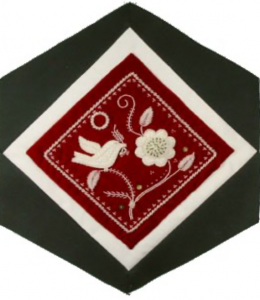Cayuga

The Block
For the Cayuga block, Lorna Thomas-Hill of the Wolf Clan, Cayuga First Nation, and her son, Samuel Thomas, have revived traditional Iroquoian art-forms, combining old and new patterns. The elegant dove and flower design is hand-sewn in iridescent pearly white beads on plush burgundy velvet.
This style of raised beadwork is an exclusive Iroquoian technique where beads are sewn one on top of the other to create three-dimensional pieces. The dove symbolizes peace, the circle eternity and continuity of life, while the strawberry flower signifies the defeat of winter, of good over evil. The strawberry is revered among the Woodlands Nations as the first fruit of Mother Earth, its juice important in spiritual rituals.
Cultural Profile
The Cayuga call themselves Gayogoho’no, which means “People of the Great Swamps,” in reference to the marshy lands that were a part of their original homelands. When they joined the Iroquois (Haudenosaunee) Confederacy around the year 1570, along with Mohawk, Onondaga, Oneida, and Seneca, they became known as the “People of the Pipe”. The Cayuga are often referred to as the Younger Brothers of the Confederacy. The establishment of the Confederacy was commemorated with the making of a wampum belt called the Hiawatha, or Aiionwatha, belt. If reading the belt looking northward the second square on the left represents the Cayuga.
Traditionally Iroquois men wore a hat called a gustoweh. The Cayuga were known for attaching an eagle feather to their gustoweh, situated in a downward tilted position. If the man was a chief, he would also attach deer antlers to his hat as a symbol of authority.
Like other members of the Confederacy, the Cayuga are a matrilineal society. They are divided into the five clans of Turtle, Bear, Wolf, Heron and Snipe. The clan mothers were responsible for raising strong leaders, but the also had the power to discipline an irresponsible leader to the point of removing him from the position of chief, by removing his antlers.
Cayuga ancestral lands lay along the northern shore of the St. Lawrence River in Ontario and northern New York State, primarily around Cayuga Lake. The steady influx of European immigrants during the 19th century brought about a gradual diminishing of Cayuga lands. Today, there are Cayuga living on reservations located in the same area, as well as in Wisconsin and Oklahoma. Many Cayuga live on the Six Nation Reserve in Ontario, along the Grand River.
Sponsor: The Sunshine Gang and The Fairweather Group
